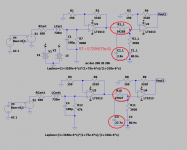I specifically made a low capacitance phono cable. 20pF/ft
It was not, however, made with this particular cartridge in mind.
I can’t hear anything above 10kHz, so the effect of increasing the load to 68K would be lost on me, sadly.
But I do appreciate the suggestion!
Re M44: I don’t find it to be round or warm. I have vintage Stanton/Pickerings for that. With the .7mil conical stylus, it is more rolled off on the top, but a bit crunchy, too. With the Extended Contact elliptical the frequency response is exactly like my digital sources.
I have some “fancy” cartridges including high dollar LOMC, but I enjoy the M44 for its dynamics. The extra voltage is fun, I think.
It was not, however, made with this particular cartridge in mind.
I can’t hear anything above 10kHz, so the effect of increasing the load to 68K would be lost on me, sadly.
But I do appreciate the suggestion!
Re M44: I don’t find it to be round or warm. I have vintage Stanton/Pickerings for that. With the .7mil conical stylus, it is more rolled off on the top, but a bit crunchy, too. With the Extended Contact elliptical the frequency response is exactly like my digital sources.
I have some “fancy” cartridges including high dollar LOMC, but I enjoy the M44 for its dynamics. The extra voltage is fun, I think.
Last edited:
I had to dig out the Lipshitz paper (from 1978) -- as a first swipe I run the simulation with a load resistor of 47k, second swipe change the cartridge load resistor to equal the inductive impedance of the cartridge at 75us, i.e.
0.72 H / 75e-6 seconds = 9,600 Ohms
Change the values of R1 and C2 to effect a much lower T5 value of 10e-6 seconds (since you are compensating by changing the cartridge load resistor.
0.72 H / 75e-6 seconds = 9,600 Ohms
Change the values of R1 and C2 to effect a much lower T5 value of 10e-6 seconds (since you are compensating by changing the cartridge load resistor.
Attachments
Hi Jackinnj,
Thanks for your response!
You even recalculated the the changes to the existing filter. That was very kind of you!
I'm excited to try this out!
Regards,
John
Thanks for your response!
You even recalculated the the changes to the existing filter. That was very kind of you!
I'm excited to try this out!
Regards,
John
I use 40X for the front end and 30X at the output - with the attenuation of the passive network, this gets me 40 dB gain at 1 kHz.
Hi Wrenchone,
Thanks for your response!
I will give that a try. From what I have read, this makes sense from a noise perspective—slightly more gain in the first stage.
I’m not sure what was wrong when I first put this little phono pre together. Maybe one of the Op Amps was actually damaged after all. Most of my Op Amps get recycled through different projects.
However, now with OPA604 in both input and output, it is sounding strangely good. I did bias the output 604 into class A with a simple resistor, but I don’t think this has much effect on the over all performance. I only did it because OPA604s generally sound a tad hazy to me.
My guess is that whoever originally calculated the filters for the datasheet did a good job. It sounds very “correct.”
Regards,
John
Thanks for your response!
I will give that a try. From what I have read, this makes sense from a noise perspective—slightly more gain in the first stage.
I’m not sure what was wrong when I first put this little phono pre together. Maybe one of the Op Amps was actually damaged after all. Most of my Op Amps get recycled through different projects.
However, now with OPA604 in both input and output, it is sounding strangely good. I did bias the output 604 into class A with a simple resistor, but I don’t think this has much effect on the over all performance. I only did it because OPA604s generally sound a tad hazy to me.
My guess is that whoever originally calculated the filters for the datasheet did a good job. It sounds very “correct.”
Regards,
John
Let me qualify the above statement: I was not expecting much from this circuit, so take the "strangely good" part with a grain of salt.However, now with OPA604 in both input and output, it is sounding strangely good.
Regards,
John

